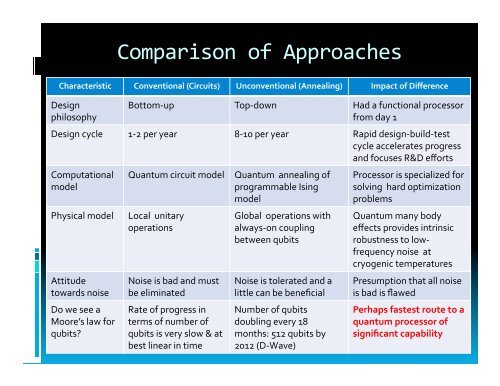X - NASA Quantum Future Technologies Conference
X - NASA Quantum Future Technologies Conference
X - NASA Quantum Future Technologies Conference
You also want an ePaper? Increase the reach of your titles
YUMPU automatically turns print PDFs into web optimized ePapers that Google loves.
Comparison of Approaches<br />
Characteristic Conventional (Circuits) Unconventional (Annealing) Impact of Difference<br />
Design<br />
philosophy<br />
Bottom-‐up Top-‐down Had a functional processor<br />
from day 1<br />
Design cycle 1-‐2 per year 8-‐10 per year Rapid design-‐build-‐test<br />
cycle accelerates progress<br />
and focuses R&D efforts<br />
Computational<br />
model<br />
Physical model Local unitary<br />
operations<br />
Attitude<br />
towards noise<br />
Do we see a<br />
Moore’s law for<br />
qubits?<br />
<strong>Quantum</strong> circuit model <strong>Quantum</strong> annealing of<br />
programmable Ising<br />
model<br />
Noise is bad and must<br />
be eliminated<br />
Rate of progress in<br />
terms of number of<br />
qubits is very slow & at<br />
best linear in time<br />
Global operations with<br />
always-‐on coupling<br />
between qubits<br />
Noise is tolerated and a<br />
little can be beneficial<br />
Number of qubits<br />
doubling every 18<br />
months: 512 qubits by<br />
2012 (D-‐Wave)<br />
Processor is specialized for<br />
solving hard optimization<br />
problems<br />
<strong>Quantum</strong> many body<br />
effects provides intrinsic<br />
robustness to low-‐<br />
frequency noise at<br />
cryogenic temperatures<br />
Presumption that all noise<br />
is bad is flawed<br />
Perhaps fastest route to a<br />
quantum processor of<br />
significant capability


